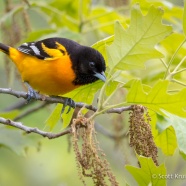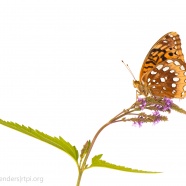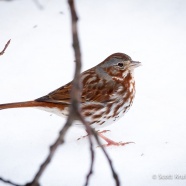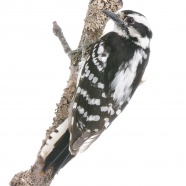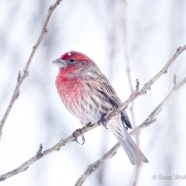Baltimore Oriole
They may be gone from our yards for the winter but I thought that as we near Halloween it was very appropriate to post this male Baltimore Oriole (Icterus galbula). I enjoyed watching it feeding in an oak tree this past spring on a cool, cloudy and windy day. Do you ever have any luck getting them to come down to eye level at your feeders? I certainly do not, and this bird hopping down to the lower branches of the tree for a minute was a real treat. I hear them every day all summer long but rarely get the chance to see a glow like this one up close. RTPI’s work around the world helps...
Read MoreThe Great Spangled Fritillary!
The Great Spangled Fritillary (Speyeria cybele) and other native butterflies provide added splashes of color on summer days as they flit about our flower gardens, parks and roadsides. Butterflies don’t need much to thrive in our immediate vicinity. As long as you take extra care to plant native flowering plants that provide healthy foods for these animals (rather than non-native ornamental plants that don’t offer such benefits to our insects) and don’t spray pesticides, butterflies will be there to brighten your day (and pollinate your other flowers and veggies)!
Read MoreFox Sparrow
Any time we see snowfall from mid-March on, we might notice an increase in the number and species diversity of birds at our backyard feeders. Those who pay close attention might also have the opportunity to view more elusive birds – those that would otherwise just be passing through or returning to the area relatively unnoticed – that are driven out of their preferred habitats by the extreme conditions in search of food. One such bird that can seem to appear out of nowhere is the Fox Sparrow (Passerella iliaca). These large sparrows really enjoy scratching at the ground with both...
Read MoreDowny Woodpecker
The Downy Woodpecker (Picoides pubescens) is an industrious little bird that frequents parks and woodlots throughout much of North America. While often spotted at backyard feeders with similarly sized chickadees and nuthatches, this black-and-white woodpecker is also at home on tiny branches where it can be seen acrobatically foraging for insect larvae. Roger Tory Peterson described this bird’s call as “a rapid whinny of notes, descending in pitch.” Keep an eye and an ear out for this charismatic little bird; its striking plumage, shrill song and tree-trunk tapping should...
Read MoreMale House Finch
Here is a recent photo of a male House Finch (Haemorhous mexicanus) on a snowy afternoon. The beautiful red shades of this guy really stand out against the drab surroundings, and their cheery songs can already be heard here in February on some of the warmer, sunnier days. It is one of the first signs of “spring” as the days began to grow longer. The Purple Finch (Haemorhous purpureus) is a similar species and often confused with the House Finch, especially because both enjoy coming to backyard bird feeders. Roger Tory Peterson described the Purple Finch as having been...
Read More



